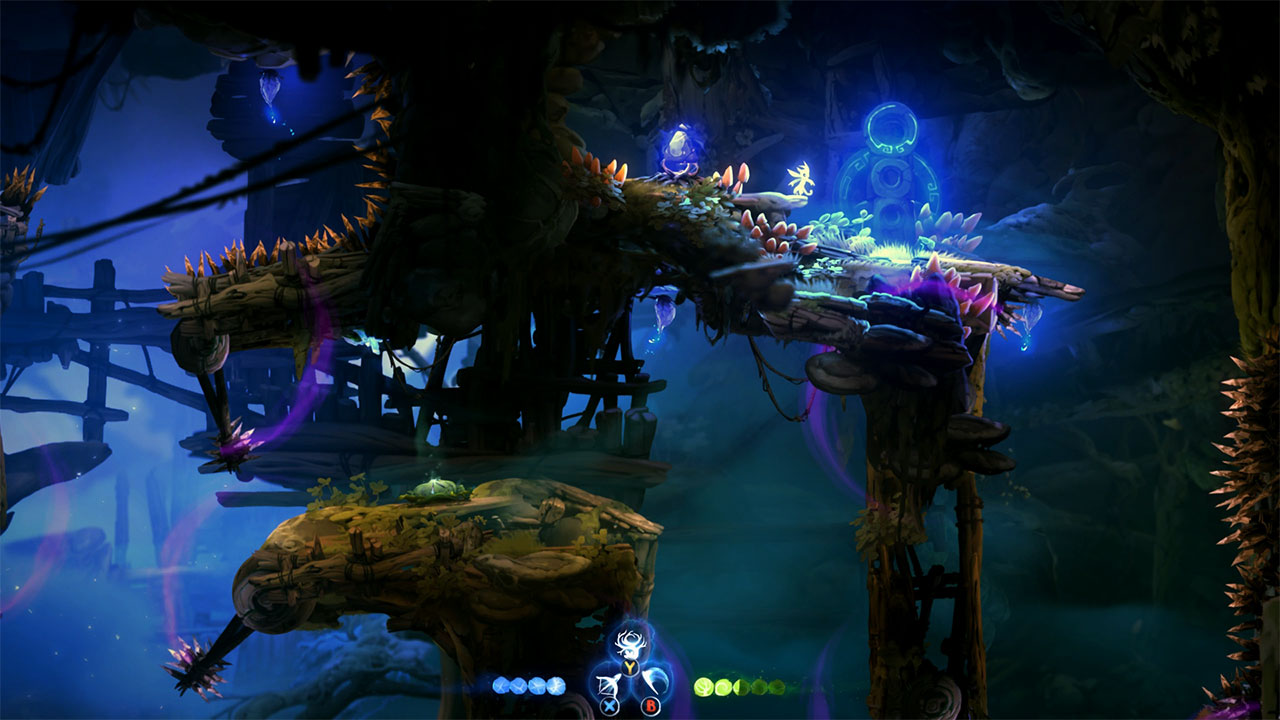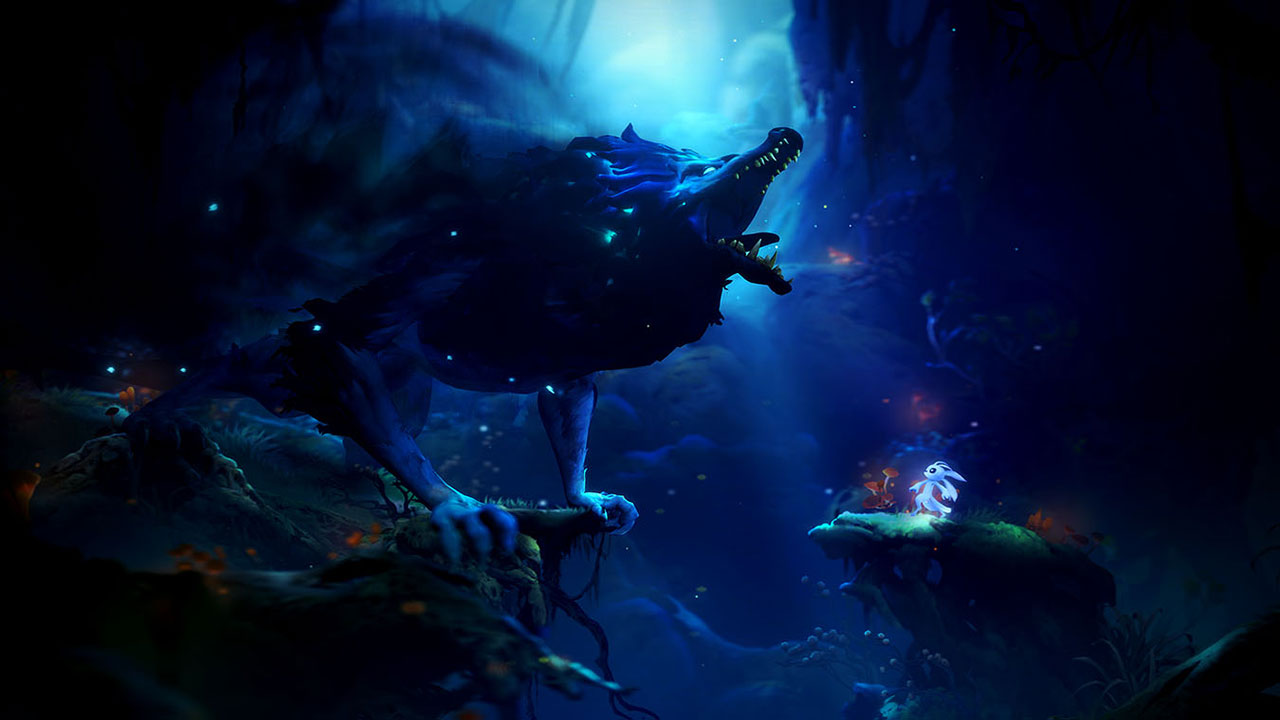The 2015 release of Ori and the Blind Forest on Xbox One was one that saw Moon Studios surprising platforming fans with a 2D platformer that stood out from the crowd. A combination of Metroidvania gameplay, a beautiful, hand-painted world, wonderful soundtrack, and the tight combat and controls that you expect from good games in this genre — it was a great first effort from Moon Studios. Now, with the release of Ori and the Will of the Wisps, Moon Studios is back with, for better or worse, with more of the same. More of that same beautiful art, music, and gameplay while pushing forward the story started in the first game.
As you will recall, the main antagonist of the first game was a giant owl named Karu that was very, very protective of her brood. Now, in Will of the Wisps you have a tie to the Blind Forest in the owl chick Ku that Ori will now be preotective of. With some familiar faces in Naru and Gumo, Ori will work with others to protect the owl chick among other objectives. We lightly touch on the story beats for Will of the Wisps because they aren’t really the star of the show here. The narrative of Ori and the Will of the Wisps definitely plays second fiddle to the other aspects and often times gets lost along the way. There’s just not enough of it and it’s told through character interactions mostly which are delivered through chat bubbles as there is no voiced dialogue between the characters.

Ori and the Will of the Wisps runs into the problems that many second games in a series do. It toes the line between offering more of the same and something fresh. Will of the Wisps does skew more towards keeping fans happy with the more of the same than it does trying anything new. With Will of the Wisps you will be hard pressed to really point out the differences between the first game and this one, but they are there. You could say that improvements have been incremental to avoid getting fans of the first game too upset. The thing to remember here is that the original Ori was a very well received game. This is a studio that won best debut for that title at the Game Developers Choice Awards. They’ve tied up a partnership with Microsoft and the product that they put out back in 2015 was a good one. It really wasn’t necessary to alter the formula that they had. So the question is, do you need more Ori?
If you played Ori and the Blind Forest hopping back in for Will of the Wisps you instantly remember what was so good about that game. The impressive artwork and 2D world that has been created here is impressive every time you see it. The great controls and Ori’s floaty jumping style that allows you to bound across and interact with this world through double and triple jumps and wall climbing make the navigation of this world a fun exercise. The constant allure of hidden items, collectibles, and progression are paced well in that you always feel like you’re finding something new. Whether that’s in new abilities that allow you to reach new areas of the world or in items that allow you to progress further or purchase upgrades for Ori. There are also more characters to find in the world. There’s a whole new cast of creatures that Ori will meet on this journey. Some are simply there to function as vendors that allow you to purchase the aforementioned upgrades, while others serve as main path story catalysts or side quest givers. Along the way you’re constantly building Ori back up to full outfit them with the abilities that they had in the previous game. There really is no rhyme or reason as to why Ori lost these powers in the first place, but that is the nature of this game. You will be tracking down, in almost all instances, the powers that you had in the first game.

It’s still probably the weakest aspect of this game as it was in Ori and the Blind Forest, but combat in Will of the Wisps has been expanded upon. There are numerous abilities that you can outfit onto Ori that allow you to attack enemies in different ways. Will of the Wisps has a nice variety of different enemy types that you’ll need to learn how to counter. Each of them has unique attacks and weakness and different ways that they must be dealt with. But even when you do get to a level of mastery with your abilities it does feel like enemies often get cheap hits on you and death is swift. I think they major problem for Ori is one of scale in the combat. Ori is relatively small on the screen compared to the rest of the world. So are the enemies, and it can just be hard to see exactly what you need to do amidst the clutter. Ori doesn’t quite get there this time around in terms of being a game that is good enough to stand on its own in this regard, but there are numerous difficulty options if combat is the thing deterring you from enjoying the game.
Ori succeeds in its presentation, but it’s also an incredibly good platformer from a controls standpoint and the way that it feels to navigate the world. There are numerous upgrades that you can find. Some are unmissable and necessary for progression. Others are optional things that improve upon Ori’s abilities. Ori has a combination of abilities that is just a lot of fun to use in concert. Bounding from surface to surface using a combination of wall jumps, double and triple jumps, and abilities that allow you to grapple or boost and dash, there are so many ways to get around this world. At times it can be a little overwhelming. Almost every button you press does something so mastering Ori’s movement abilities can be a little challenging. Putting the game down and coming back to it can be a little overwhelming. Ori’s movement abilities are certainly not simplistic, but really do offer a sense of accomplishment when mastered.

That mastery can be carried over to another new feature of the game with the Spirit Trials that have been added. Players can use all of the abilities at their disposal to make their way through sets of challenges which function as a sort of time-trial. This mode is scored through a leaderboard so if this aspect of the game is something that you like, you can always tackle these trials while playing the game. You simply walk up to one of the locations in the game world, select the trial and then the course will be shown to you. The objective is to make it to the finish line in the fastest way possible. When you take into consideration how many different ways these things can be tackled, the speed run aspect to this very well could offer some replay value.
Putting it all together, Ori and the Will of the Wisps is another big win for Moon Studios. While our review of the game was initially marred with some performance issues that had questioning what had happened between the first and second games, they were ultimately righted by the day one patch. Other than that, we really couldn’t find anything or any reason that would stop you playing Ori and the Will of Wisps. It’s more of what made Ori and the Blind Forest a lot of fun and a memorable experience. It’s solid, tight platformer with a great presentation. It’s still fairly weak in terms of combat and while the improvements to building out this world are noteworthy through the addition of side quests and a bunch of new characters to meet, the world can feel a little flat still. It can still be quite frustrating to replay different sections again and again to get things right. Taking the good with the bad, Ori and the Will of Wisps is a worthy follow-up and a must-play for fans of the first game. If you haven’t played the original, it’s a fine platformer that you’ll likely find worth the time.
The Verdict
Moon Studios doesn’t necessarily break new ground with Ori and the Will of the Wisps and that’s OK. The additions that have been made improve on the experience, eventhough it’s hard to be as impressed as we were the first time around.











Published: Mar 10, 2020 10:49 am